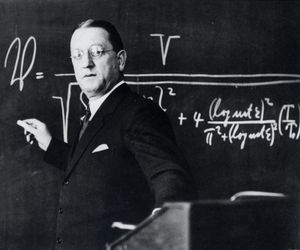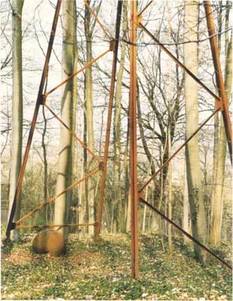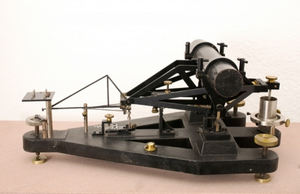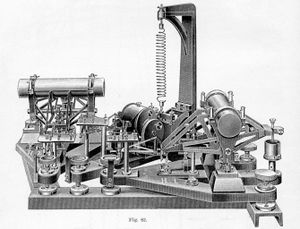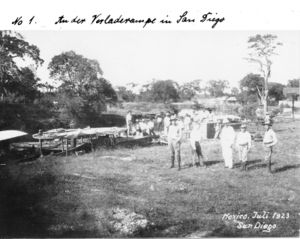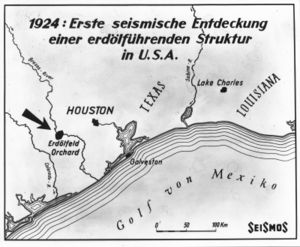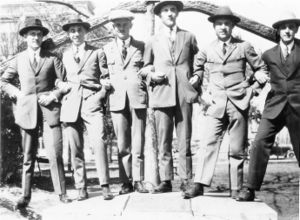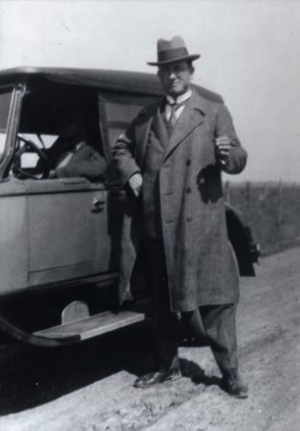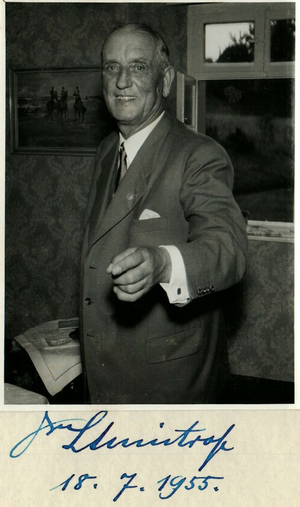Ludger Benedikt Mintrop
- Birthdate
- 1880/07/18
- Birthplace
- Werden an der Ruhr, Essen, Germany
- Death date
- 1956/01/01
Biography
The original version of this article was created by Francesco Gerali, 2020 Elizabeth & Emerson Pugh Scholar in Residence at the IEEE History Center
It is recommended this article be cited as:
F. Gerali (2020). Ludger Benedikt Mintrop, Engineering and Technology History Wiki. [Online] Available: https://ethw.org/Ludger_Benedikt_Mintrop
Studies, academic and professional career
Ludger Benedikt Mintrop (July 18, 1880 Werden an der Ruhr (modern day Essen) - January 1, 1956 Essen) was a German surveyor mining engineer and geophysicist. He is considered to be the inventor of the earlier commercial seismic method for the exploration of hydrocarbons and minerals patented in 1919, used first in Germany to localize salt domes, and then petroleum, gas, and ores in and outside Europe.
After completing primary school at Realgymnasium in Aachen, Mintrop first completed an internship in the mining industry and then began studying mining sciences and practices at the Bergakademie Berlin.[1] After successfully passing the Abitur[2] examination in Aachen, he enrolled with prof. Karl Haußmann at the Aachen Technical University in 1903. On May 12, 1905, Mintrop sustained the Markscheider[3] examination at the Oberbergamt in Dortmund[4] and was the designated assistant of Karl Haußmann, who later fell into poor health, and Mintrop assumed the role of delivering the lectures for his classes. Upon the advice of Haußmann, Mintrop moved to Göttingen in 1907 under the famous earthquake researcher prof. Emil Wiechert[5] (1861-1928), the scientist who greatly contributed to the development of geophysics as an independent discipline. Ludger Mintrop entered the Geophysical Institute of the University of Gottingen, where he could implement his knowledge of his lifelong interest, and from the inspirational teaching and mentorship of prof. Wiechert, head of the Geophysical Institute.[6]
The seismological research undertook in Göttingen [7] at that time resulted in major progresses in both seismogram evaluation and general theory. Relevant results were achieved mostly due to the high-quality data delivered by the early Wiechert seismographs crafted in the Göttingen University laboratories. Much of the seminal scientific work on seismology published in Germany at the beginning of the 20th century concerns seismic attenuation[8] (a principle developed by Gustav Angenheister in 1906), the method for earthquake location (Geiger method),[9] the designing of earth models (Wiechert, Geiger, and Gutenberg), the calculation and gauging of amplitude ratios[10] at boundaries (Zoeppritz equations),[11] the first reliable proof of the boundary between the Earth’s mantle and crust at a 2,900 meter depth (Gutenberg), the principle of microseismics (Gutenberg), head waves (Mintrop wave), and the inverse method for exploring the physical properties of the Earth’s interior based on the travel times of seismic waves measured on the Earth’s surface (the Wiechert-Herglotz method).[12]
Between 1907 and 1911, Mintrop divided his time between taking courses under Emil Wiechert and in filling the position as teacher in the School of Mines in Bochum. In addition to teaching, he set up the seismological station in 1907 on behalf of the Westphalian Mining Union and was in charge of it. The same year, he set up active experiments with the Mintrop Ball,[13] marking the beginning of the seismic exploration of near-surface geological layers (Fig. 1). Up to this time the Mintrop experimentation had been mostly devoted to recording and studying artificial earthquakes produced by the dropping of four-ton, steel-made, heavy masses[14] (Fig. 2).
On August 9, 1910, Mintrop married the mayor's daughter Elisabeth Sartorius, who came from Essen-Rellinghausen. He completed his studies in Göttingen on February 1, 1911, defending his dissertation on the propagation of sound waves Über die Ausbreitung der von den Massendrucken einer Großgasmaschine erzeugten Bodenschwingungen ("On the spreading of ground vibrations generated by the mass pressures of a large gas engine"). Mintrop continued to work as professor at the Bochum School of Mínes until Germany entered the war in 1914, when he joined the army (Fig. 3).
War and Geophysics
In October 1914, when the Western Front of World War I was stabilized, the heavy artillery was a strategic offensive importance on both sides. The experience gained in using early seismic networks to locate the origin of distant earthquakes led to the attempt of locating the artillery positions of the enemy. From 1915, French and British armies displaced in the battlefield seismic troops composed by scientists specialized in reading the speed and the radius of propagation of the waves.
Mintrop and other scientists enrolled as officers and tried to interest General Headquarters in the practical value of portable seismographs as a means of spotting the location of enemy artillery from 1914 to 1917. He could make no headway with his idea until the battle of the Somme, which forced the German Military High Command to take further actions. Eventually, in 1917, Mintrop was ordered to start building sound-ranging seismographs. Material and technical assistance were difficult to find, and the construction of the sound-ranging equipment went slowly. Ludger Mintrop sought to gain the positions as Head of the army sound-ranging division but at the very end his unit played a minor role. Nevertheless, it was Mintrop's two-year effort on the battlefields that provided the impetus to make German sound-ranging technology efficient, reliable and accessible outside of an academic setting. Although no one considered this at the time, the involvement of a physicist in the location of artillery would lead to the practice of seismic exploration for petroleum and natural gas.
In late 1917, when he was still member of the army artillery examination commission, he received patents for a vibration meter (working with highly sensitive carbon-grain microphones, the precursor of the modern geophone), a light field seismograph and a method for determining the location of artificial vibrations. The sound waves in this instance were refracted waves.[15] This type of wave enters the earth at an angle but then changes direction at a shallow strata and proceeds parallel to the earth’s surface to get picked up by a seismograph. After the war, Mintrop began applying the refraction method to petroleum exploration by using a dynamite explosion to create an artificial sound wave. In 1919, Mintrop made some improvements on his war-time mechanical seismograph and filed the German patent No. 371963, titled Method for the Determination of Rock Structures (Fig. 4).
In 1920 Mintrop discovered the appearance of the head wave in the seismic wave field, which is the basis for seismic refraction measurements. The same year he was elected a member of The Deutsche Akademie der Naturforscher Leopoldina.[16]
Salt domes and petroleum fields: German achievements in waves refraction
In 1920-1921, Mintrop constructed test lines across two known German salt domes near Berlin and Hannover. From there, Mintrop started to profile terrains across Germany, intending to pick up an unknown salt dome. He succeeded in accomplishing this with the discovery of the Meissendorf salt dome. This find had no commercial significance, but its discovery represented a remarkable step forward in the discipline since it was the first salt dome in the world detected by seismic means.
The Seismos GmbH - Zur Erforschung von Gebirgsschichten und Nutzbaren Lagerstätten nach dem Seismischen Verfahren (Seismos GmbH - For the Exploration of Mountain Strata and Usable Deposits Using the Seismic Method) was founded on April 4, 1921 by Ludger Mintrop in Dortmund, then based in Hannover (Fig. 5). Mintrop established the company with the ambitious goal of searching for crude petroleum and gas reservoirs on a global scale. His work received sustained support from his teacher Emil Wiechert and was even financed by five German metallurgical and mining companies.
Together with Emil Wiechert, Karl Erich Andrée, Gustav Angenheister, Immanuel Friedländer, Beno Gutenberg, Franz Kossmat, Gerhard Krumbach, Karl Mack, Peter Polis, and August Heinrich Sieberg, Ludger Benedikt Mintrop was a founding member of the German Seismological Society in Leipzig, which was formed on on September 19, 1922, today the German Geophysical Society. (Deutsche Geophysikalische Gesellschaft e.V.).[17]
From 1922, Seismos was committed in petroleum and ore finding in Germany, the Netherlands, Poland and elsewhere in Europe. In 1923, the company launched its first overseas seismic exploration campaign in Mexico. Seismos started working in March for the Mexican Eagle Oil Company (established in 1909 by Weetman Pearson, Viscount Cowdray from 1910, and after 1916 owned by the Anglo-Dutch SHELL) in the Golden Lane area of Mexico and continued the operations for approximately a year with good results (Fig. 6).
In 1924, the most famous salt dome region of the United States, Texas, came under scrutiny by Seismos operators. This campaign represented a turning point is the Seismos corporate future. Their key to success in Texas was the previous knowledge of the acoustic properties of salt acquired in Germany. Seismic waves travel faster through salt than most sediments, so to locate the salt domes, the Seismos crews analyzed the recordings of their seismographs for particularly fast travel times. Mintrop’s fame peaked in June 1924 when a Seismos crew discovered the famous petroleum-rich Orchard Salt Dome in Fort Bend County, Texas (Fig. 7). This find was the first success using the new seismic method in the United States; furthermore it was spectacular enough to begin displacing the less precise magnetic and gravity measurement systems. This achievement led to an extensive campaign of refraction shootings against competitors such as Petty Geophysical Engineering in San Antonio (Fig. 8). Seismos worked extensively in the United States[18] (as well in Europe, Latin America and Africa) under contract for many petroleum and mining firms. When his technology was globally acknowledged as efficient and reliable, Mintrop in the 1930s made to sale the rights of his patents to local companies and making a good fortune (Fig. 9). By 1930, most of the shallow domes on the Gulf Coast had been discovered. The same year, in acknowledgment of his groundbreaking results in geophysics, Ludger Mintrop, together with the fellow scientist and competitor Everette Lee DeGolyer,[19] was elected as the first honorary member of the neo-constituted Society of Exploration Geophysicists.
The following year, Seismos ended its commitment in refraction operations, although the technique continued to be offered by other companies. The technology in 1956 was instrumental in the discovery of the Hassi Messaoud field, Algeria’s largest reservoir at the time. In 1934, Seismos reorganized itself and began offering the services of another even more promising seismic technique called reflection seismic.
During his corporate experience, Ludger Mintrop was appointed professor of geophysics and mine prospection from 1928 to 1945 at the University of Breslau, and from 1946 to 1948 at RWTH Aachen University.[20] On May 19, 1949, shortly after his retirement from professorship, Mintrop was awarded an honorary doctorate by the Montanistische Hochschule Leoben[21] (The Mining High School of Leoben, Austria) for his achievements in applied geophysics. On September 9, 1955, he received The Order of Merit of the Federal Republic of Germany[22] from DFR President Theodor Heuss(Fig 10).
The company Die Gesellschaft für praktische Lagerstättenforschung GmbH, later Prakla (founded on March 23, 1937 in Berlin) merged together with the Seismos in Hannover in 1963 to constitute the Prakla-Seismos[23] (PRAKLA-SEISMOS), a global prospecting company committed in land, aerial and maritime geophysical exploration.[24]
Conclusion
The early physicists of the geophysical discipline had little notions of applied geology, and early geologists concerned about geophysical matters had no notions of how to put together a set of working instruments, or how to use them if they were designed by someone else. The case of Mintrop was different. Primarily a mining engineer with relevant field experience as surveyor, his understanding of geology was sound and adequate. Furthermore, he had a sufficient comprehension of physics to visualize what was needed to craft an instrument (the recording seismograph) that would be an aid to the solution of both mining and geological problems. In this respect Mintrop was a cross disciplinary scientist-practitioner member of that cadre of young scientists educated and shaped by Emil Wiechert in Gottingen: the archetype of complete geophysicist of the early days of experimental applied geophysics. Having a good foundation in both physical and geological principles, Mintrop had the great opportunity to make the difference in the petroleum finding becoming a pioneer and then a leading operator in refraction applied to petroleum and gas research.
In acknowledgement of Mintrop legacy,[25] since 1997 the European Association of Geoscientists and Engineers (EAGE) grants The Ludger Mintrop Award[26] to the best paper published on the journal Near Surface Geophysics[27] in the calendar year preceding the award.
Selected works of Ludger Benedikt Mintrop
Mintrop, Ludger B. 1911. Über die Ausbreitung der von den Massendrucken einer Großgasmaschine erzeugten Bodenschwingungen. Essen: Girardet. (Dissertation defended at the Göttingen University in 1911).
Mintrop, Ludger B. 1916. Einführung in die Markscheidekunde. mit besonderer Berücksichtigung des Steinkohlenbergbaues. 2. verbesserte Auflage. Berlin: Springer. (Second edition 1923).
Mintrop, Ludger B. 1916. Beobachtungsbuch für markscheiderische Messungen. 3. verbesserte Auflage. Berlin: Springer.
Mintrop, Ludger B. 1930. “Zur Geschichte des seismischen Verfahrens zur Erforschung von Gebirgsschichten und nutzbaren Lagerstätten”. In: Mitteilungen der Seismos-Gesellschaft. Selbstverlag der Seismos 2. Hannover [Königshof]: Selbstverl. d. Seismos.
Mintrop, Ludger B. 1931. Das Institut für Markscheidekunde und Geophysik der Technischen Hochschule Breslau. Breslau: Inst. f. Markscheidekunde und Geophysik der Technischen Hochschule Breslau.
Mintrop, Ludger B. 1941. “Geophysikalische Verfahren zur Erforschung von Gebirgsschichten und Lagerstätten”. In: Die technische Entwickelung des deutschen Steinkohlenbergbaues seit der Jahrhundertwende. Band 1 (Markscheidewesen), Teil 1. Essen: Glückauf,
Mintrop, Ludger. 1947. “100 Jahre physikalische Erdbebenforschung uns Sprengseismik”, “Die Naturwissenschaften 9 & 10: 258-262; 289-295.
Mintrop, Ludger. 1953. “Die entwicklung des Sprengseismik.” Zeitschrift für Geophysik 19: 101-122.
References
Bates, Charles C., Thomas F. Gaskell, and Robert B. Rice. 1997. Geophysics in the Affairs of Man: a Personalized History of Exploration Geophysics and Its Allied Sciences of Seismology and Oceanography. Kent: Elsevier Science.
Fertig, J. 1989. “Mintrop seminars in Germany: History and ideas.” The Leading Edge 8 no. 11:42
Gerali, Francesco. From the Western Front to Texas: early development of seismic exploration for oil (1914-1926). Conference paper presented at the 41st ICOHTEC Meeting, Brasov, Romania, Session T1C, Thursday 31.
Herrmann, Helmut, Bucksch, Herbert. 2014. Mintrop wave. Dictionary Geotechnical Engineering -Wörterbuch GeoTechnik. Springer-Verlag Berlin Heidelberg.
Keppner, G. (January 01, 2006). Ludger Mintrop. Mitteilungen / Deutsche Geophysikalische Gesellschaft 1( 2006): 4 – 17.
Kroker, Evelyn, "Mintrop, Ludger" in: Neue Deutsche Biographie 17 (1994), S. 546 f. [Online-Version]; URL: https://www.deutsche-biographie.de/pnd117048844.html#ndbcontent
Lehmann, Karl. 1965. Ludger Mintrop: der große Markscheider und Geophysiker; ein Lebensbild. Herne: Kartenberg.
Menzel, H. 1956. “Ludger Mintrop 18. Juli 1880 - 1. Januar 1956”. Deutsche Hydrographische Zeitschrift 8, no. 165 (July 1955).
Norm, Domenico. 1996. “The Mintrop mechanical seismograph.” The Leading Edge 15, no. 9:1049.
Sweet, George Elliott. 1978. The history of geophysical prospecting. Sudbury: Neville Spearman.
See also
Further Reading
- ↑ https://www.geo.tu-berlin.de/menue/ueber_uns/historie/
- ↑ https://www.etymonline.com/word/abitur
- ↑ https://tureng.com/en/german-english/markscheider
- ↑ https://www.ulb.uni-muenster.de/sammlungen/historisch/landesoberbergamt.html
- ↑ https://www.erdbebenwarte.de/en/emil-wiechert-1861-1928/
- ↑ https://agupubs.onlinelibrary.wiley.com/doi/pdf/10.1029/01EO00123
- ↑ https://www.erdbebenwarte.de/en/geschichte/
- ↑ https://earthquake.usgs.gov/learn/glossary/?term=attenuation
- ↑ https://gfzpublic.gfz-potsdam.de/rest/items/item_43361_4/component/file_56133/content
- ↑ http://www.che.ncku.edu.tw/facultyweb/changct/html/teaching/Process%20Control/Chapter_13_Chang.ppt
- ↑ https://www.semanticscholar.org/paper/Linearization-of-Zoeppritz-equations-and-practical-Oladapo-Ilesanmi/b6b30cf934ad4b2e3424c5a22ac5c9d7136cb15a
- ↑ http://rses.anu.edu.au/~hrvoje/PHYS3070/Lecture7.pdf
- ↑ ftp://ftp.norsar.no/pub/outgoing/johannes/hist/goett_2.pdf.
- ↑ https://www.amusingplanet.com/2018/03/the-4-ton-steel-ball-that-produces.html
- ↑ https://www.ucl.ac.uk/EarthSci/people/lidunka/GEOL2014/Geophysics4%20-%20Seismic%20waves/Seismology/An%20Introduction%20to%20Seismic%20Refraction%20Theory%20and%20Application.htm
- ↑ https://www.leopoldina.org/en/about-us/about-the-leopoldina/history/
- ↑ https://dgg-online.de/
- ↑ http://www.wdiehl.de/PS/PS_HTML/Filmarchiv/ps_filmarchiv_hmenue_container.php?menue=ps_filmarchiv_menue.php&content=HTML5/video_all.php&fuss=ps_start_fusszeile.php
- ↑ https://www.tamupress.com/book/9781623491826/oilfield-revolutionary/
- ↑ https://www.rwth-aachen.de/cms/~a/root/
- ↑ https://www.unileoben.ac.at/en/3023/
- ↑ https://www.bundespraesident.de/EN/Role-and-Functions/HonoursAndDecorations/TheOrderOfMerit/theorderofmerit-node.html
- ↑ https://www.prakla-seismos.de/
- ↑ http://www.wdiehl.de/PS/PS_HTML/Filmarchiv/ps_filmarchiv_hmenue_container.php?menue=ps_filmarchiv_menue.php&content=HTML5/video_all.php&fuss=ps_start_fusszeile.php
- ↑ http://www.wdiehl.de/PS/PS_HTML/Filmarchiv/ps_filmarchiv_hmenue_container.php?menue=ps_filmarchiv_menue.php&content=HTML5/video_all.php&fuss=ps_start_fusszeile.php
- ↑ https://www.eage.org/en/about-eage/awards/overview-awards/ludger-mintrop-award
- ↑ https://www.earthdoc.org/content/journals/nsg
